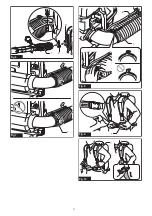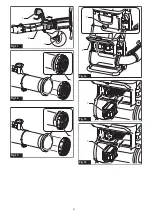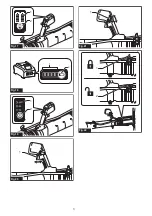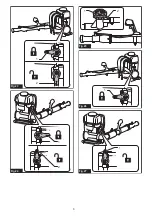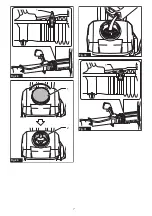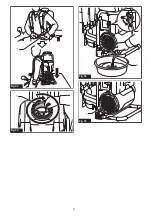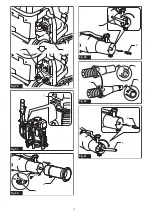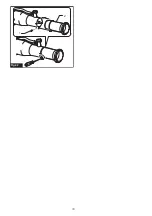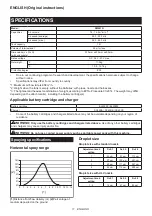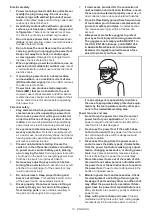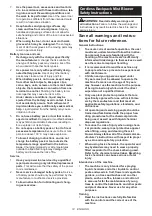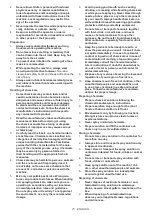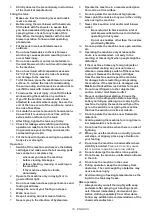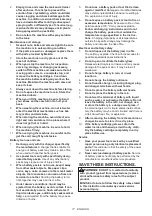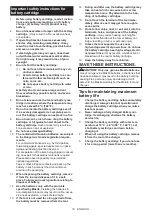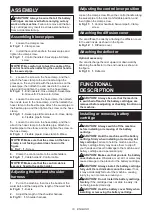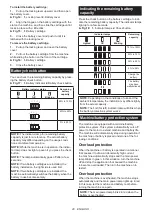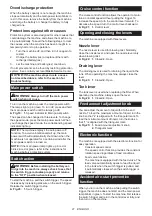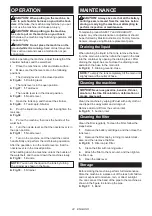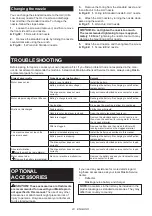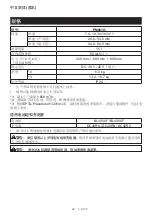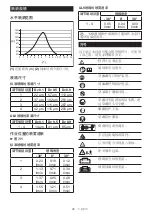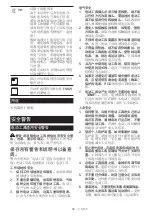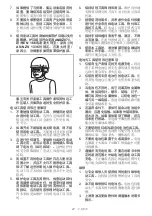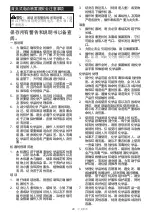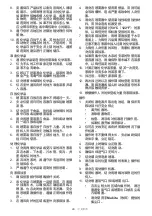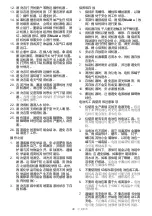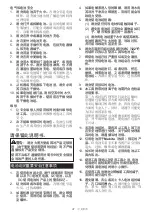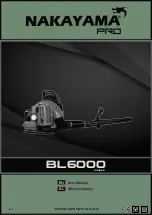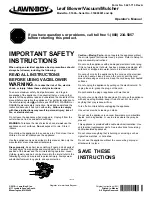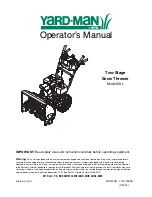
16 ENGLISH
3.
Strictly observe the precautionary instructions
of the chemical manufacturer.
Filling the tank
1.
Make sure that the draining lever and nozzle
lever are closed.
2.
Before using the mist blower with chemicals,
fill the tank with fresh water to assure that
you have assembled it properly and practice
spraying. Also, check for any leaks at this
time. When thoroughly familiar with the mist
blower operation, follow normal operating
procedures.
3.
Fill the tank in well-ventilated areas or
outdoors.
4.
Do not use flammables in the mist blower,
which may cause explosion resulting in seri-
ous or fatal injury.
5.
Do not use caustic or corrosive materials in
the mist blower, which could result in damage
to the machine.
6.
Do not use liquid with temperature exceeds
50 °C (122 °F) to reduce the risk of scalding
and damage to the machine.
7.
To fill the tank, place the mist blower on a level
surface. To reduce the risk of contaminating
the surrounding environment, be careful not to
overfill the tank with chemical solution.
8.
To reduce the risk of injury, do not fill the tank
while wearing the machine on your back.
9.
If you fill the solution container with a hose
attached to a central water supply, be sure the
end of the hose is out of the solution to reduce
the risk of backflow.
10.
Calculate the correct amount of chemical solu-
tion so that it is used up at one time, with no
extra solution left over in the tank.
11.
After filling, tighten the tank cap firmly.
12.
Check for leakage while refilling and during
operation. A leak from the tank or a loose fit
-
ting could soak your clothing and come into
contact with your skin.
13.
Fill the tank with liquid according to operator's
body size or strength.
Operation
1.
Switch off the machine and remove the battery
cartridges and make sure that all moving parts
have come to a complete stop
•
whenever you leave the machine.
•
before clearing blockages.
•
before checking, cleaning or working on
the machine.
•
if the machine starts to vibrate
abnormally.
2.
Operate the machine only in daylight or in
good artificial light.
3.
Do not overreach and keep proper balance and
footing at all times.
4.
Always be sure of your footing on slopes.
5.
Walk, never run.
6.
Keep all cooling air inlets clear of debris.
7.
Never spray in the direction of bystanders.
8.
Operate the machine in a recommended posi-
tion and on a firm surface.
9.
Do not operate the machine at high places.
10.
Never point the nozzle at anyone in the vicinity
when using the machine.
11.
Never block suction inlet and/or mist blower
outlet.
•
Be careful not to block suction inlet or
mist blower outlet with dust or dirt when
operating in dusty area.
•
Do not use nozzles other than the nozzles
provided by Makita.
12.
Do not operate the machine near open window,
etc.
13.
Operating the machine only at reasonable
hours is recommended - not early in the
morning or late at night when people might be
disturbed.
14.
If the machine strikes any foreign objects or
should start making any unusual noise or
vibration, immediately switch off the machine
to stop it. Remove the battery cartridges
from the machine and inspect the machine
for damage before restarting and operating
the machine. If the machine is damaged, ask
Makita Authorized Service Centers for repair.
15.
Do not insert fingers or other objects into
suction inlet or mist blower outlet.
16.
Prevent unintentional starting. Ensure the
switch is in the off-position before inserting
battery cartridges, picking up or carrying the
machine. Carrying the machine with your fin
-
ger on the switch or energizing the machine
that has the switch on invites accidents.
17.
Do not operate the machine near flammable
materials.
18.
Avoid operating the machine for a long time in
low temperature environment.
19.
Do not use the machine when there is a risk of
lightning.
20.
When you use the machine on muddy ground,
wet slope, or slippery place, pay attention to
your footing.
21.
Do not use the machine in bad weather where
visibility is limited.
Failure to do so may cause
fall or incorrect operation due to low visibility.
22.
Do not submerge the machine into a puddle.
23.
Do not leave the machine unattended outdoors
in the rain.
24.
Do not use the machine in the snow.
25.
During operation, keep the cord away from
obstacles. The cord caught by obstacles may
cause serious injury.
26.
Avoid working in freezing temperatures as the
liquid in the tank may freeze.
After operation
1.
Always wash yourself thoroughly with soap
and water after spraying or handling chemi-
cals. Shower immediately, and wash all pro-
tective clothing separately from other items.
Follow any additional recommendations of the
chemical manufacturer.
Summary of Contents for PM001G
Page 2: ...2 0 30 30 Fig 1 1 Fig 2 1 2 3 Fig 3 6 1 2 3 4 5 Fig 4 2 1 4 3 5 Fig 5 ...
Page 3: ...3 3 2 1 Fig 6 1 Fig 7 1 2 Fig 8 1 Fig 9 1 Fig 10 ...
Page 4: ...4 1 2 3 Fig 11 1 Fig 12 1 Fig 13 1 2 Fig 14 1 Fig 15 1 Fig 16 ...
Page 5: ...5 1 2 Fig 17 1 2 Fig 18 1 2 Fig 19 1 Fig 20 1 Fig 21 1 2 Fig 22 ...
Page 6: ...6 1 2 Fig 23 1 2 Fig 24 2 1 Fig 25 1 Fig 26 1 Fig 27 ...
Page 7: ...7 1 Fig 28 1 2 Fig 29 Fig 30 1 Fig 31 ...
Page 8: ...8 1 Fig 32 1 Fig 33 1 2 Fig 34 1 Fig 35 ...
Page 9: ...9 2 1 Fig 36 1 Fig 37 1 2 Fig 38 1 2 Fig 39 1 2 3 Fig 40 1 2 Fig 41 ...
Page 10: ...10 1 2 Fig 42 ...
Page 99: ...99 ...


